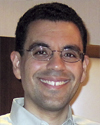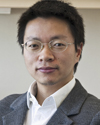NIH Fosters High-Risk, High-Reward Innovation at UCSF
Five Win Award Funding to Study Lung Cancer, Asthma, Schizophrenia and Other Areas
Biomedical researchers at UCSF have won five of 51 prestigious National Institutes of Health (NIH) Director’s New Innovator awards for high-risk, high-reward research, each receiving up to $1.5 million over five years.
In their investigations, the UCSF researchers will be creatively applying or developing new technologies to probe lung cancer; asthma; schizophrenia; inborn blood disorders, such as sickle cell anemia and “bubble boy disease;” and the couplings of proteins that drive all cellular and intercellular actions within the organism, in health and in disease.
The five UCSF awardees announced Thursday by the NIH are:
- Christopher D.C. Allen, PhD
Project Title: Cellular Interactions in Asthma - Trever G. Bivona, MD, PhD
Project Title: Discovery of Rational Companion Therapeutic Targets to Optimize Cancer Treatment - Xiaokun Shu, PhD
Project Title: New Principle-Based Technologies for identifying Transient Protein Interactions - Vikaas S. Sohal, MD, PhD
Project Title: Reverse Engineering the Prefrontal Microcircuit - Ann C. Zovein, MD
Project Title: Engineering Human Endothelium for Hematopoietic Stem Cell Production
The researchers — who recently began their faculty careers — represent continued success among young UCSF scientists.
UCSF's Record of Success in NIH Funding
UCSF received more research funds — $532.8 million — from the National Institutes of Health (NIH) than any other public institution in 2011 and ranked second among all institutions nationwide. In 2010, UCSF also was the largest public recipient, with $475.4 million in funding.
According to the NIH, the goal of the award, established in 2007, is to support “exceptionally innovative” research among scientists who are just beginning to establish their own labs. The anticipated result is the more rapid generation of scientific breakthroughs that are quickly translated into better health for patients.
The New Innovator award initiative is part of the NIH Common Fund’s High Risk-High Reward program, and supports investigators who are within 10 years of having received their final academic degree or clinical residency but have not yet received a major NIH grant.
“The Common Fund High Risk-High Reward program provides opportunities for innovative investigators in any area of health research to take risks when the potential impact in biomedical and behavioral science is high,” said NIH Director Francis Collins, MD, PhD.
Visualizing Inflammatory Cells in Asthma

Christopher D.C. Allen, Ph.D.
Asthma is becoming increasingly common worldwide, especially among children, according to Christopher Allen, PhD, the first Sandler-Newmann Foundation UCSF Fellow in Asthma Research.
In response to triggers such as pollen, mold, viral infection or even cold air, airways within the lungs of a person with asthma constrict as inflammatory cells chronically infiltrate. The disease can be fatal.
“These inflammatory cells have been shown to make an important contribution to disease pathology, yet despite what we have learned, current treatments for the disease remain inadequate,” Allen said.
In the past, knocking out genes and using inhibitors of inflammatory molecules produced by cells in the lungs of mice with asthma provided pieces of the puzzle. Now with the support of the New Innovator award, Allen is turning to the microscope to learn more about how asthma arises and persists. Allen is at the forefront in applying a cutting-edge technology called two-photon microscopy to the study of disease.
Allen will track the movement of inflammatory cells within the lung in a way that could not be done before, and he expects to make new discoveries about important cellular and molecular interactions within lung structures in asthma.
Overcoming Lung Cancer Tumors that Resist Treatment

Trever G. Bivona, M.D., Ph.D.
Medical oncologist Trever Bivona, MD, PhD, is working to develop and validate a new research approach to study how lung cancers respond differently to treatment in different patients, due to different patterns of gene activation and protein production in the tumor cells that can adapt over time during therapy. He hopes to make advances in tailoring treatments more precisely to individual tumors and developing treatment strategies for overcoming the problem of drug resistance that currently limits even our best cancer therapies.
Bivona will apply the new technical innovations to define the mechanisms through which genes and proteins act through signaling networks to evade even newer, targeted therapies. He’ll develop and test new ideas for blocking these key signaling pathways in tumor cells with rational combinations of drugs, similar to the way HIV now is targeted successfully in patients.
“Our overall goal is to characterize the molecular determinants of response to targeted therapies,” Bivona said. “We want to design effective combination therapies that strike against the most critical factors promoting tumor cell growth and that prevent or overcome resistance to treatment, thus improving the survival of patients with lung cancer and other cancers.”
From Genome to Interactome

Xiaokun Shu, Ph.D.
In his young career Xiaokun Shu, PhD, has proven adept at theoretical physics, biophysics and chemical biology, including development of new highly sensitive fluorescent markers for studying physiology of living animals under a microscope. Now, with a NIH New Innovator award, he will pursue something in yet another field.
Proteins do most of the work in living things, acting cooperatively to perform myriad required tasks. Many proteins change work partners as the surrounding environment changes and different jobs must be performed to adapt.
Just as genomes have been sequenced, protein populations in different cell types in various organisms have been catalogued as “proteomes.” But beyond research aimed at defining genomes and proteomes, there remains the newer and only recently approachable challenge of mapping the “interactome,” an atlas of how proteins interact with one another to drive and control biological events.
Key to understanding the interactome, Shu said, are weak, short-lived interactions among proteins. When proteins are not stuck together for life and instead can change partners, they can better respond to the needs of a changing environment at the level of the cell, a key organ or the entire organism. When they respond abnormally, disease may result.
However, only strong, long-lived protein interactions are easily detected with current methods of protein purification and fingerprinting by a technique called mass spectroscopy.
Shu is developing a way to similarly track down those weakly interacting proteins, which will be key to generating the massive amounts of data needed to construct the human interactome.
“Biology today is where physics and astronomy were long ago,” Shu said. “Massive amounts of data need to be generated and interpreted so that underlying principles can be unveiled, just like Johannes Kepler derived his laws of planetary motion by analyzing Tycho Brahe’s massive amount of astronomical observations.”
Reverse Engineering Nerve Circuits in Schizophrenia

Vikaas S. Sohal, M.D., Ph.D.
Scientists have linked schizophrenia and related disorders to specific brain regions, but so far these discoveries have not led to better treatments.
“We don’t know how the properties of cells or their interactions give rise to patterns of activity that enable these brain regions to carry out functions, including the ones that are impaired in psychiatric illnesses,” according to UCSF neuroscientist Vikaas Singh Sohal, PhD.
Sohal aims to “reverse engineer” circuits in the brain that are involved in schizophrenia. To do so, he will measure activity within brain circuits known to be affected by schizophrenia, in a way that makes it possible to infer both their overall function and the contributions that specific types of cells make to this function.
Sohal will focus on circuits in the prefrontal cortex that play a major role in the human ability to make decisions and navigate social interactions, and malfunction in many psychiatric disorders such as schizophrenia. He will use new technologies together with ideas from math and physics to determine how these circuits process information. He then will study how this function is altered in mice that are used to model schizophrenia and other disorders.
“Whereas many existing ideas about schizophrenia and related disorders tend to focus on excesses or deficiencies of particular chemicals in the brain, we hope that our studies will lead to new, nerve circuit-based ways to understand and treat these disorders,” Sohal said.
Stem Cell Strategy for a Better Source of Blood

Ann C. Zovein, M.D.
Pediatrician Ann Zovein, MD, aims to manipulate mature blood vessel cells to generate stems cells that can be stored and activated as needed to produce human blood.
In her developing research program, she studies the diversification and maturation of blood vessels, the specializations of different cells associated with blood vessels, and the role of these cells in vascular diseases.
The stem cells in the bone marrow that give rise to the blood system and all its specialized cells — including red blood cells, clot-controlling platelets and immune cells — actually originate in the newly formed aorta when the embryo is between four and seven weeks old.
These stem cells then migrate to the bone marrow, where they are known as hematopoietic stem cells and remain throughout life. On the other hand, cells in the blood vessel — called endothelium — normally mature, specialize and lose any hematopoietic stem cells that could spin off blood or immune cells.
Zovein is manipulating the activation of key genes that determine the properties of stem cells or specialized cells with the goal of undoing cell maturation and specialization, known as “differentiation.” By turning back the developmental clock on blood vessel cells, without going back so far that their identity as blood-derived tissue is lost, Zovein aims to produce stem cell lines that can be maintained indefinitely and will reliably generate blood.
“By taking the approach of cellular de-differentiation with maintenance of tissue identity, we hope to reinitiate the hemogenic program in mature endothelium for human blood production,” she said.